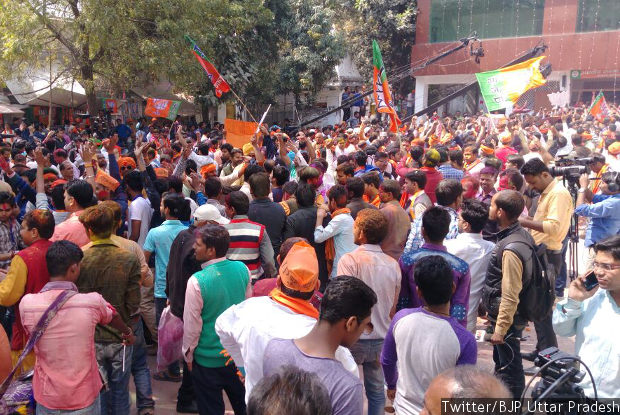UP’s Modi Wave Unprecedented In 40 Years
Workers of the Bharatiya Janata Party (BJP) celebrate at its Uttar Pradesh (UP) headquarters in Lucknow. The BJP's performance in UP is the best by any party after 1977, when the Janata Party won 352 seats of 425.
In an outcome unmatched over the last 40 years, the Bharatiya Janata Party (BJP) won 312 out of 403 (77.4%) seats in India’s largest state assembly in its most-populous state, increasing its vote share by 25 percentage points from the 2012 assembly elections to 39.7% in 2017.
The BJP almost repeated its performance from the 2014 parliamentary elections, when it won 42.7% votes and 73 (more than 90%) of 80 Lok Sabha seats. Despite the effects of demonetisation and the perception that voters behave differently in parliamentary and assembly elections, it would take a historic vote swing favouring the Samajwadi Party (SP)-Congress alliance or the Bahujan Samaj Party (BSP) to keep the BJP from sweeping UP, as IndiaSpend had predicted in January 2017.
This performance--vote share, and seats won as a percentage of total seats--is the best by any party after 1977, when, in the wake of the Emergency being lifted, the Janata Party won 352 seats of 425 (82.8%) seats and garnered 47.8% votes from the people of UP.
The BJP almost exactly replicated the performance of the Congress in 1980, when the Congress won 309 seats with 39.6% of the votes, while the BJP won 11 seats with 10.8% votes. In 2017, the BJP has 312 seats with 39.7% votes, while the Congress has seven seats with 6.2% of UP’s votes.
Regional parties SP and BSP maintain vote share, fail to win seats
As the chart shows, the SP and BSP maintained their core vote share of at least 20%--the SP had 29% of the votes in 2012 and the BSP, 26%--in the 2017 assembly elections, but they could not translate those into seats.
Source: Election Commission of India data here and here
Our analysis of assembly elections since 1993, after the formation of the SP, shows that both SP and BSP were consistent in growing their vote shares, while the vote shares of the major national parties, the BJP and the Congress, reduced.
Source: Election Commission of India data here and here
The BJP in 2017 has registered its best performance ever, the Congress its worst ever since 1977, and the SP and BSP the worst ever since their inception.
After being the single largest party and forming the government for one term (1997-2002) in the 1993-2002 period, the BJP remained out of power in UP for 15 years. The Congress never again achieved the 15% vote share it achieved in 1993.
The BSP improved its vote share from the 19.8% in 2014 Lok Sabha election to 22.2% in the 2017; in 2012, it won 26% of the vote share, winning 80 seats; in 2017 it is down to 19.
BJP makes U-shaped recovery, Congress continues downfall
Looking back at the last four decades, the BJP started modestly in 1980, winning 11 seats with 11% of UP’s votes, as we said.
Source: Election Commission of India data here and here
So dominant were the SP and BSP over the last 30 years, the BJP and Congress were compared with a third front.
Except for three of the last 11 state elections, non-Congress and non-BJP parties put together always garnered more than a third of the votes, winning more than half the state’s vote in 2007.
In the four decades since 1980, UP was ruled by the Congress the first decade, followed by the BJP’s rise and a fractured mandate that benefitted regional parties in 1989 and 1993 during the second decade, followed by 15 years of regional party dominance.
Note: For elections prior to 2002, the figures are for undivided Uttar Pradesh, including present-day Uttarakhand.
(Waghmare is an analyst with IndiaSpend.)
We welcome feedback. Please write to respond@indiaspend.org. We reserve the right to edit responses for language and grammar.
__________________________________________________________________
“Liked this story? Indiaspend.org is a non-profit, and we depend on readers like you to drive our public-interest journalism efforts. Donate Rs 500; Rs 1,000, Rs 2,000.”



